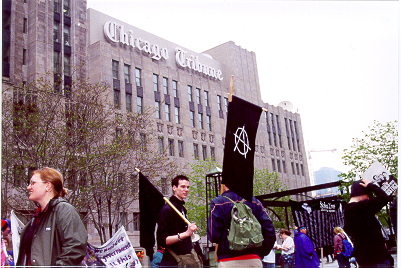|
|
|||||||||||
|
|
||
|
|
|
|
|
|
||
| The New Commune
By Joseph Simonian It is remarkable that one of the hubs of our contemporary economy, Silicon Valley, is full of firms that operate on principles that in many ways resemble those of anarchist-communism. These firms have brought radical technology and an equally radical organizational approach that set them apart from other technological centers. In Silicon Valley, individuality, experiment, and spontaneity, are all highly valued. These values are shared with anarchist-communism and a case can be made that much of the success of Silicon Valley can be attributed to the adoption of such ideas. Silicon Valley firms usually do business the ‘Hewlett-Packard way’ .
The ‘HP way’ is a management style that eradicates many of the hierarchical
structures of traditional corporations, including reserved parking spaces,
private offices, and elaborate ranking systems. Stock options and profit
sharing are identical for all employees. A decentralized structure is employed
giving each business unit autonomy with respect to product development,
marketing, and personnel. When a unit gets too big, it is broken down into
a smaller unit. There is no ‘command center’ that must be reported to at
every step. The corporate office is responsible for providing an overall
strategy and a uniform administrative infrastructure. All of this is designed
to enhance flexibility and creativity. An almost religious fervor for new
technology binds employees to one another. United by the quest for the
next technological breakthrough, the workers share a commitment to an ideal
that runs deeper than self-interest. Finally, since high-tech industries
often require less capital to begin operations than many traditional industries,
the value of capital is diminished to a great extent. Since what makes
or breaks most hi-tech firms is not the machines they use but the people
working behind them, the value of the individual employee and her needs
increases.
Anarchist-communes are composed of one of two types of organizations: the ‘commune’, which is territorial, and the ‘syndicate’, which is industrial. Each is intended to be an autonomous, small and collectively controlled body that will federate with other communes or syndicates to deal with large-scale issues. The communes and syndicates are characterized by spontaneity, trial and error, and experiment. Most forms of anarchism advocate either the complete abolishment of private property or collective ownership. A common ideology frequently binds members of communes together, as is the case with the agrarian Tolstoyans in nineteenth century Russia. The advantages of utilizing anarchist ideas in the workplace have been recognized for quite some time. Pierre-Joseph Proudhoun and Michael Bakunin felt that workers must control the means of production so that they will receive the full benefits of their labors. Peter Kropotkin argued that establishing communal forms of organization would eliminate competition amongst workers and allow the natural tendencies of ‘mutual aid’ and cooperation to emerge. Charles Handy has envisioned firms that will not have employees but ‘members’ who will have a say in company strategy and will be united by a commitment to something beyond profits. E.F. Schumacher advocated smaller-scale production, a concept of work that emphasized fulfillment over the profit-motive, and a consideration of collective forms of ownership within the context of the free-market. It is clear then, that there is much support for the adoption of anarchist-communist ideas in business. Whether the ‘HP way’ is a harbinger of things to come or a simply a successful fluke, it is clear that at least part of the success of Silicon Valley firms can be attributed to their shift away from the traditional corporate structure to a more egalitarian organization. |
||
|
Columbia/Barnard Economics Society |
||



